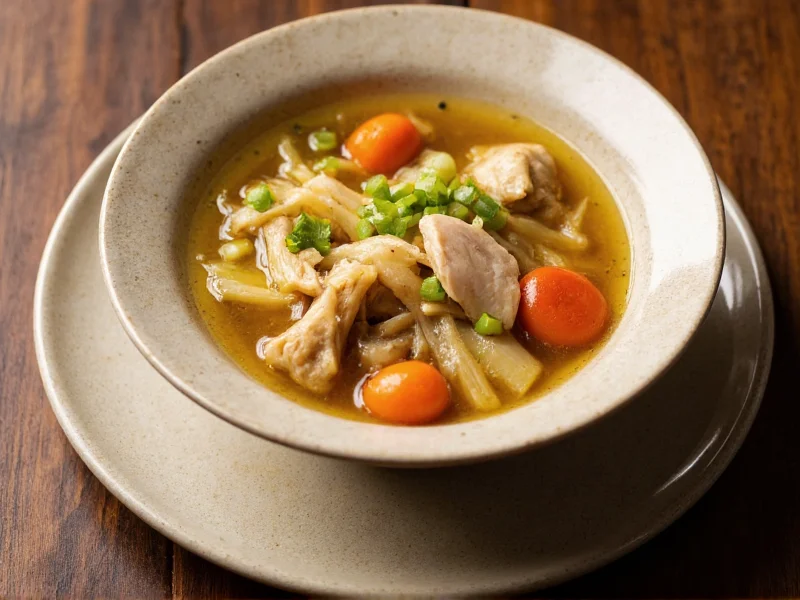Chicken and cabbage soup represents one of the most versatile comfort foods across global cuisines, from Eastern European borscht variations to Asian-inspired broths. This nutrient-dense combination offers remarkable health benefits while requiring minimal culinary expertise. The magic lies in how cabbage's natural sweetness balances perfectly with savory chicken, creating a satisfying meal under 400 calories that supports weight management and gut health.
Essential Ingredients and Their Purpose
Creating an exceptional chicken and cabbage soup requires understanding each component's role. While regional variations exist, these core ingredients form the foundation of a perfect broth:
| Ingredient | Function | Substitution Options |
|---|---|---|
| Boneless chicken thighs | Provides rich flavor and stays tender during simmering | Breast meat (cook less time), turkey, or tofu for vegetarian version |
| Green cabbage | Adds sweetness and texture; red cabbage works but changes color | Savoy cabbage (softer texture), Napa cabbage (milder flavor) |
| Yellow onion | Creates flavor base; never skip this aromatic foundation | Shallots or leeks for more delicate flavor |
| Garlic | Essential depth; add near end to prevent bitterness | 1 tsp garlic powder in pinch (less ideal) |
| Carrots | Natural sweetness and color; classic in European versions | Parsnips or celery root for variation |
Step-by-Step Preparation Guide
Follow these professional techniques for restaurant-quality chicken cabbage soup at home. This easy chicken and cabbage soup recipe requires just one pot and delivers maximum flavor through proper technique.
Building Flavor Foundations
Start by heating 1 tablespoon olive oil in a 5-6 quart pot over medium heat. Add 1 diced yellow onion and 2 diced carrots, cooking until translucent (about 5 minutes). This critical step develops flavor through the Maillard reaction—don't rush it. Add 2 minced garlic cloves during the last minute to prevent burning.
Simmering for Perfect Texture
Pour in 6 cups low-sodium chicken broth and bring to a gentle simmer. Add 1 pound boneless chicken thighs (not breasts, which dry out faster) and 4 cups chopped cabbage. Include flavor enhancers: 1 bay leaf, 1 teaspoon dried thyme, and a Parmesan rind if available. Simmer uncovered for 20-25 minutes until chicken reaches 165°F internally.
Finishing Touches
Remove chicken and shred with two forks. Return to pot with 1 cup frozen peas and 2 tablespoons fresh dill. Never add cabbage too early—it becomes mushy. For authentic traditional chicken cabbage soup, finish with lemon juice to brighten flavors, not cream. This technique preserves the clean, refreshing quality that makes this healthy chicken cabbage soup so appealing.
Variations for Different Dietary Needs
Adapt this basic framework for various preferences while maintaining integrity. These chicken cabbage soup variations demonstrate the recipe's remarkable flexibility:
- Keto version: Replace carrots with celery and add 1/2 cup heavy cream at the end (making it chicken cabbage soup with cream)
- Eastern European style: Add 2 tablespoons tomato paste and 1 diced beet for color
- Asian-inspired: Use ginger instead of thyme, add soy sauce, and finish with rice noodles
- Quick chicken cabbage soup: Use rotisserie chicken and pre-shredded cabbage for 20-minute preparation
Troubleshooting Common Problems
Even simple soups encounter issues. These solutions ensure success with your best chicken cabbage soup recipe:
Preventing Bitter Cabbage
Cabbage turns bitter when overcooked or exposed to acidic ingredients too early. Always add cabbage during the last 15 minutes of cooking. If bitterness occurs, stir in 1 teaspoon sugar or a splash of cream to neutralize.
Fixing Watery Broth
For a richer broth without cream (chicken cabbage soup without cream), simmer uncovered for additional 10-15 minutes to reduce liquid. Alternatively, mix 1 tablespoon cornstarch with 2 tablespoons cold water and stir in during final minutes.
Keeping Chicken Tender
Chicken breast dries out quickly in soup. For chicken cabbage soup with carrots using breast meat, add it during the last 10 minutes of cooking. Thighs remain tender throughout simmering—ideal for meal prep versions.
Nutritional Benefits and Meal Planning
This chicken cabbage soup for weight loss delivers impressive nutritional value per serving (based on 1.5 cups):
- 320 calories with 28g protein
- 12g dietary fiber from cabbage and carrots
- 115% of daily vitamin C needs
- 45% of daily vitamin K requirement
- Naturally low in carbohydrates (18g net carbs)
The high water content (92% in cabbage) creates volume eating—helping you feel full on fewer calories. For maximum gut health benefits, include the cabbage core which contains concentrated fiber. This makes it an excellent choice for digestive wellness without compromising flavor.
Serving and Storage Recommendations
For optimal flavor development, let the soup rest for 24 hours before serving—this allows flavors to meld completely. Reheat gently to preserve cabbage texture. Store in airtight containers for up to 5 days or freeze for 3 months. When reheating frozen portions, add a splash of broth as liquid may absorb into cabbage during storage.
Perfect Pairings
Complement your healthy chicken cabbage soup with these serving suggestions:
- Crusty whole-grain bread for dipping
- Simple green salad with lemon vinaigrette
- Roasted root vegetables for heartier meal
- Side of quinoa or brown rice for added substance











 浙公网安备
33010002000092号
浙公网安备
33010002000092号 浙B2-20120091-4
浙B2-20120091-4